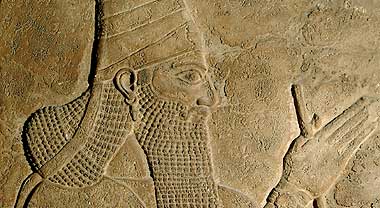

During the reign of Tiglath-Pileser III (747-722 B.C.E.), Assyria's size and power grew immensely. According to biblical and Assyrian records, Tiglath-Pileser's dominance extended over large parts of the Middle East, including Judea.
The Annals of Tiglath-Pileser from ca. 730 B.C.E. recount the imposition of tribute on several conquered kingdoms in the Middle East. The Bible records that, by exacting fifty shekels of silver from each wealthy man, Menahem, king of the northern kingdom of Israel, was able to raise sufficient tribute to cause the Assyrian king to withdraw his armies.
Menahem was succeeded by King Pekah in 738 B.C.E. In 733 B.C.E., an alliance of vassal states led by King Pekah of Israel and King Rezin of Damascus revolted against the yoke of Syrian rule. According to Assyrian records, Tiglath-Pileser's armies marched back into the Kingdom of Israel, defeated Pekah's army, and deported large proportions of the Israelite population from the Galilee. Pekah was subsequently assassinated and Hoshea was installed by the Assyrians as king of Israel. The northern kingdom of Israel retained nominal independence until 725-722 B.C.E. when Tiglath-Pileser's successor, Shalmaneser V, besieged and destroyed Israel after King Hoshea foolishly withheld tribute from the Assyrians.
Next >>
 
|
|